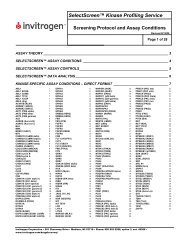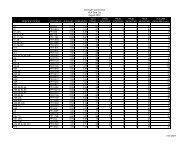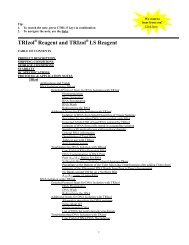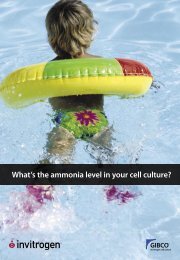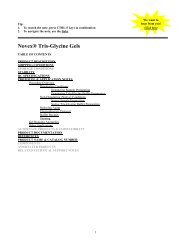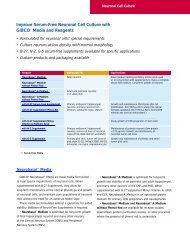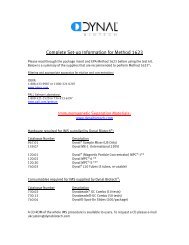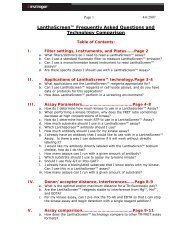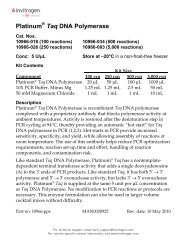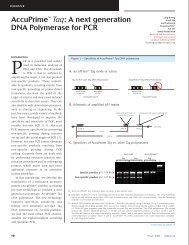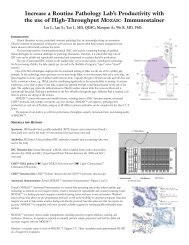Specifications of Xeotron's Human Cancer Xeochips - Invitrogen
Specifications of Xeotron's Human Cancer Xeochips - Invitrogen
Specifications of Xeotron's Human Cancer Xeochips - Invitrogen
You also want an ePaper? Increase the reach of your titles
YUMPU automatically turns print PDFs into web optimized ePapers that Google loves.
<strong>Specifications</strong> <strong>of</strong> Xeotron’s<br />
XeoChip TM Gene Expression Bioarray
Xeochip Microarrays<br />
<strong>Human</strong> <strong>Cancer</strong> <strong>Xeochips</strong> were<br />
synthesized in situ using Xeotron’s<br />
patented PGR chemistry on<br />
micr<strong>of</strong>luidic chips. A total <strong>of</strong> 3728<br />
unique cancer genes are represented on<br />
the <strong>Human</strong> <strong>Cancer</strong> Xeochip by single<br />
45 mer oligonucleotide probes. These<br />
were derived from the National <strong>Cancer</strong><br />
Institute’s database, CGAP, and<br />
designed based on algorithms to<br />
optimize Tm, CG content and<br />
sequence complexity. In addition, for<br />
these experiments, a <strong>Human</strong><br />
Minicancer Xeochip with 252 probes<br />
repeated 15 times for a total <strong>of</strong> 3780<br />
was synthesized. An additional 384<br />
probes are present as redundancies<br />
designed for housekeeping,<br />
hybridization, and synthesis controls.<br />
2<br />
RNA Labeling<br />
Total RNA was purchased from<br />
Clonetech and reprecipitated in ethanol<br />
prior to use. Each experiment was<br />
performed with 100 µg <strong>of</strong> RNA, 50 µg<br />
labeled with Cy3 dye and 50 µg with<br />
Cy5 dye using Xeotron’s cDNA<br />
labeling kit. Briefly, 50 µg <strong>of</strong> total<br />
RNA was incubated with oligo dT<br />
primers, dNTP’s reverse transcriptase<br />
and the appropriate Cy dye in buffer at<br />
42° C for 90 min. The RNA was then<br />
removed by hydrolysis with NaOH at<br />
an increased temperature <strong>of</strong> 65° C for<br />
10 minutes. The resulting labeled<br />
cDNA was purified by elution from<br />
QIAGEN QiaQuick columns in 50 ul<br />
<strong>of</strong> 0.1X TE. Probe quality was<br />
assessed by measuring the O.D. ratios.<br />
Typically, cDNA with labeling ratios<br />
between 4 and 20 were obtained and<br />
used in the experiments. This<br />
translated into approximately 200 to<br />
400 ng. <strong>of</strong> labeled cDNA. Xeotron’s<br />
labeling kit is shown in Figure 1.<br />
Figure 1. Xeotron’s cDNA<br />
Labeling Kit
Microarray Hybridization<br />
Prior to hybridization the samples were<br />
pooled and evaporated in a Speed Vac.<br />
BSA (1mg/ml), formamide, and 20<br />
XSSPE were added to make the final<br />
concentration 6X SSPE and 25%<br />
formamide in 100 µl . Control spikes<br />
were added as indicated.<br />
Hybridizations were performed for 18<br />
hours at 32 °C by recirculating the<br />
sample through the microarray using<br />
Xeotron’s Manual Micr<strong>of</strong>luidic<br />
Station. Figure 2A.<br />
Microarray Washing<br />
Washing <strong>of</strong> the microarrays was<br />
performed by removal <strong>of</strong> the sample,<br />
followed by circulating 500 µl <strong>of</strong> 6X<br />
SSPE containing 25% formamide, 500<br />
ul <strong>of</strong> 6X SSPE and finally 500 µl <strong>of</strong><br />
1 X SSPE, sequentially. To stabilize<br />
the helices 250 µl <strong>of</strong> 6X SSPE was<br />
pumped through the chip for imaging.<br />
The bioarrays were imaged on an<br />
Axon 4000 B scanner at 100% power,<br />
120-micron focus, and PMT adjusted<br />
to the appropriate setting.<br />
3<br />
Analysis<br />
Analysis <strong>of</strong> the arrays was performed<br />
using ArrayPro s<strong>of</strong>tware (Cybermedia)<br />
and BiochipTools, a Matlab program,<br />
developed in-house. Array Pro was<br />
used to produce the rectangular grid<br />
necessary for feature extraction. Once<br />
extracted, the values were loaded into<br />
the Matlab program for analysis.<br />
Figure 2B. Xeotron’s<br />
BiochipTools for high<br />
throughput data processing and<br />
chip performance evaluation.<br />
Figure 2A. Xeotron’s Manual<br />
Micr<strong>of</strong>luidic Station
These experiments were designed to<br />
determine Xeochip performance when<br />
hybridized under optimal conditions.<br />
The specifications examined included<br />
sensitivity, signal noise, specificity,<br />
and spot variation. Bioarrays were<br />
also examined for probe performance<br />
and accuracy.<br />
Sensitivity,<br />
Linear Dynamic Range, and<br />
These experiments demonstrate the<br />
Xeochip is linear over 4 logs.<br />
To determine the lowest level <strong>of</strong><br />
detection (LLD) <strong>of</strong> the Xeochip, 1% <strong>of</strong><br />
the background intensity (excluding<br />
features which contained no<br />
oligonucleotide probe) was subtracted<br />
from the signal intensities. The<br />
concentration <strong>of</strong> target that could be<br />
detected after this calculation was<br />
Positional Effects 16 fM or approximately 0.96 per 10 6<br />
To measure the sensitivity and linear<br />
dynamic range <strong>of</strong> the Xeochip, a 45<br />
mer oligonucleotide labeled with Cy3<br />
was used as the target. The<br />
complementary probe was synthesized<br />
in 20 positions throughout the<br />
Xeochip. Figure 3 demonstrates that<br />
signal was detected at values as low as<br />
0.01 pM and the signal was linear to<br />
1000 pM with a regression coefficient<br />
<strong>of</strong> 0.97.<br />
LogSignal<br />
100000000<br />
10000000<br />
1000000<br />
100000<br />
10000<br />
1000<br />
100<br />
10<br />
(1 copy/cell).<br />
Sensitivity and Linear Dynamic Range<br />
This data further demonstrates that the<br />
reproducibility <strong>of</strong> hybridization on the<br />
Xeochip is not a function <strong>of</strong> position.<br />
The c.v. for each group <strong>of</strong> data was<br />
less than 12% with an average value <strong>of</strong><br />
8.8%.<br />
R 2 = 0.9747<br />
1<br />
0.01 0.1 1 10 100 1000 10000<br />
Target Concentration (pM)<br />
Figure 3. Line graph showing the linear dynamic range<br />
<strong>of</strong> the Xeochip using an oligonucleotide probe labeled<br />
with Cy3 dye.<br />
4
System Noise<br />
To evaluate system noise in our<br />
bioarrays, self versus self<br />
hybridizations were performed on the<br />
<strong>Human</strong> <strong>Cancer</strong> XeoChip. Significant<br />
deviation from a log ratio <strong>of</strong> 0 will<br />
lead to false positives. Background<br />
intensities <strong>of</strong> control features<br />
containing no probe are extremely low<br />
in these arrays; therefore, in order to<br />
increase stringency, 3% <strong>of</strong> the lowest<br />
signal intensities plus the standard<br />
deviation was subtracted from each<br />
intensity value prior to calculation <strong>of</strong><br />
the results. Figure 4 is a representative<br />
histogram showing the log ratios.<br />
Greater than 96% <strong>of</strong> the population fall<br />
between -0.176 and 0.176 which is<br />
equivalent to a 1.5-fold change in<br />
either direction. Data for this figure<br />
was derived from the log ratio plot<br />
shown in Figure 3.<br />
5<br />
Figure 4. Histogram <strong>of</strong> log ratios for self<br />
versus self experiments. Data shown is<br />
a representative experiment in which<br />
universal RNA was used as the target.<br />
Data is from the XeoEX <strong>Human</strong> <strong>Cancer</strong><br />
bioarray containing 3899 probes shown<br />
in Figure 5.<br />
Figure 5. Representative<br />
log ratio plot <strong>of</strong> self<br />
versus self experiments<br />
performed with universal<br />
RNA on the <strong>Human</strong><br />
<strong>Cancer</strong> Xeochip. Blue<br />
data points are<br />
statistically similar to<br />
each other and therefore<br />
have a log ratio <strong>of</strong> 0.<br />
Red data points are<br />
statistically different. All<br />
statistical data is<br />
collected at a<br />
p value < 0.01.
Specificity <strong>of</strong> Hybridization<br />
Xeotron uses the GAP gene as a<br />
housekeeping control and to monitor<br />
hybridization specificity for human<br />
samples. On each Xeochip, eight<br />
redundant perfect match GAP probes<br />
and GAP probes with three adjacent<br />
mismatches are included. Figure 6<br />
shows the data from 14 independent<br />
experiments.<br />
Even at temperatures as low as 24 °C,<br />
specificity is still extremely precise.<br />
This data indicates that through the use<br />
<strong>of</strong> Xeotron’s <strong>Xeochips</strong> and<br />
Micr<strong>of</strong>luidic systems, sequences must<br />
have at least 93% homology to the<br />
probes on the <strong>Xeochips</strong> before signal<br />
will be detected.<br />
Figure 6. Demonstration <strong>of</strong> specificity <strong>of</strong> Xeochip. Plotted are intensity<br />
results from 14 individual experiments over a range <strong>of</strong> hybridization<br />
temperatures from 24 °C to 42 °C. The top graph is the perfect match probe;<br />
while the bottom is the mismatched probe. <strong>Xeochips</strong> are now routinely<br />
hybridized at 32 °C in the presence <strong>of</strong> formamide.<br />
Xeochip Probe Performance<br />
To validate Xeochip probe design three<br />
experiments were performed using<br />
universal RNA labeled with Cy3 and<br />
Cy5. Background was calculated by<br />
first excluding all blanks features. The<br />
lowest 2% <strong>of</strong> the signal intensities were<br />
6<br />
then averaged and the standard deviation<br />
derived. These values were summed and<br />
then subtracted from each individual<br />
intensity. In each case, over 3200<br />
probes showed intensity levels over<br />
background, accounting for greater than<br />
85% <strong>of</strong> the total number found on the<br />
<strong>Human</strong> <strong>Cancer</strong> Xeochip.
Accuracy <strong>of</strong> Log Ratio<br />
To assess the accuracy <strong>of</strong> the log ratio,<br />
and ultimately the quality <strong>of</strong> the data<br />
derived from the Xeochip, a series <strong>of</strong><br />
hybridizations were performed with a<br />
synthetic 90 mer transcript prepared in<br />
an in vitro reaction.<br />
The transcript was labeled with either<br />
Cy3 or Cy5 and mixed at the ratios<br />
indicated in the table below. Figure 7<br />
shows the expected and observed log<br />
ratios <strong>of</strong> the spikes.<br />
Transcript Target Cy3 Target Cy5 Target Spike-in ratio (Cy3:Cy5)<br />
PUC5 5 ng 5 ng 1:1<br />
PUC6 5 ng 20 ng 1:4<br />
PUC25 5 ng 80 ng 1:16<br />
PUC27 5 ng 640 ng 1:128<br />
Figure 7. Titration <strong>of</strong> Cy3 labeled or Cy5 labeled transcript to measure the<br />
accuracy <strong>of</strong> the log ratio.<br />
7
Xeochip Performance<br />
Spot uniformity is an indication <strong>of</strong> the<br />
quality <strong>of</strong> an array. High uniformity is<br />
obtained when the pixel strength is<br />
equivalent throughout the spot. Since<br />
the probes on the Xeochip are<br />
synthesized in situ, Xeochip spots<br />
typically have low c.v. values. Figure 8<br />
demonstrates that spots on any single<br />
XeoChip have, on average, less than<br />
10% c.v. Data averaged from three<br />
<strong>Human</strong> <strong>Cancer</strong> XeoChips yielded c.v.<br />
values <strong>of</strong> 0.045 for the Cy3 channel and<br />
0.065 for the Cy5 channel.<br />
In addition, because the spot<br />
uniformity is so consistent with<br />
<strong>Xeochips</strong>, they are much easier to grid.<br />
Xeotron provides a grid file that can be<br />
quickly snapped into place. Figure 9 is<br />
an image <strong>of</strong> a typical chip gridded and<br />
ready for data extraction.<br />
Figure 8. Representative histogram <strong>of</strong> spot c.v. for (right panel) the Cy3<br />
channel and (left panel) the Cy5 channel. A total <strong>of</strong> more than 280 genes<br />
were used in these measurements from a <strong>Human</strong> <strong>Cancer</strong> Xeochip<br />
8<br />
Figure 9. Close-up <strong>of</strong> a<br />
Xeochip with a grid. Because<br />
<strong>of</strong> the uniformity <strong>of</strong> the<br />
Xeochip, A Xeotron supplied<br />
grid is simply overlaid to a tiff<br />
image and pulled into place.
Reproducibility<br />
As a measure <strong>of</strong> reproducibility, spot-tospot<br />
c.v.s were compared. After<br />
background subtraction, 259 features<br />
were compared on two separate <strong>Human</strong><br />
<strong>Cancer</strong> XeoChips for both the Cy3 and<br />
the Cy5 channel (Figure 10). The<br />
average c.v. for the Cy3 channel was<br />
10% while that for the Cy5 channel was<br />
12%.<br />
Figure 10. Representative histogram showing spot-to spot c.v.<br />
(Right panel) The Cy3 channel had an average c.v. <strong>of</strong> 10% while<br />
(left panel) the Cy5 channel had an average c.v. <strong>of</strong> 12%.<br />
Figure 11. Hierarchical clustering analyses for 25 experiments, in<br />
which 12 experiments used universal cDNA for both Cy3 and Cy5 and<br />
13 experiments used skeletal muscle versus brain cDNA. Consistency<br />
<strong>of</strong> ratio measurements is observed.<br />
9
Detection <strong>of</strong> Differential Expression<br />
To investigate the accuracy <strong>of</strong> detecting<br />
differential expression, a series <strong>of</strong><br />
experiments were performed using<br />
labeled cDNA prepared from either total<br />
brain or skeletal muscle RNA. Five<br />
Minicancer <strong>Xeochips</strong> were hybridized to<br />
a 1:1 mixture <strong>of</strong> the labeled cDNA.<br />
Figure 12 is a representative image from<br />
an experiment in which the muscle RNA<br />
was labeled with Cy3 and the brain with<br />
Cy5. To further demonstrate<br />
reproducibility, the color reversal<br />
experiment was performed and the<br />
results are also shown in Figure 13. In<br />
this case the brain cDNA was labeled<br />
with Cy3 while the skeletal muscle was<br />
labeled with Cy5.<br />
Figure 12. (Left panel) Representative log plot <strong>of</strong> the differential<br />
expression <strong>of</strong> genes in skeletal muscle RNA (Cy3) vs. brain RNA (Cy5).<br />
(Right panel) Representative log plot <strong>of</strong> the differential expression <strong>of</strong><br />
genes in brain RNA (Cy3) vs. skeletal muscle RNA (Cy5). The red data<br />
points are genes significantly differentially expressed (p
Figure 13. Color reversal experiment demonstrating<br />
reproducibility <strong>of</strong> <strong>Human</strong> <strong>Cancer</strong> Xeochip. Data was derived<br />
from plots above. (Left panel) Log ratio <strong>of</strong> the skeletal muscle<br />
(Cy3) to brain (Cy5) vs the brain (Cy3) to skeletal muscle (Cy3).<br />
This data has a regression correlation coefficient <strong>of</strong> 0.89.<br />
(Right panel) Data from separate <strong>Xeochips</strong> using the labels as<br />
before were compared in silico. In this case the regression<br />
coefficient was 0.96. This demonstrates the reproducibility <strong>of</strong><br />
the Xeochip.<br />
11



